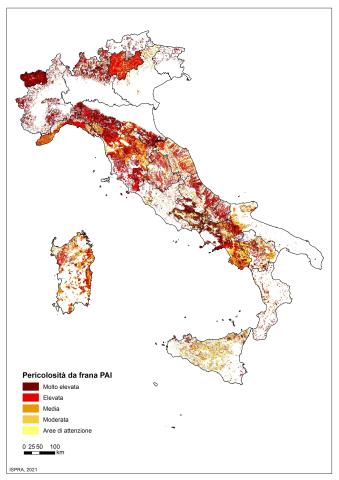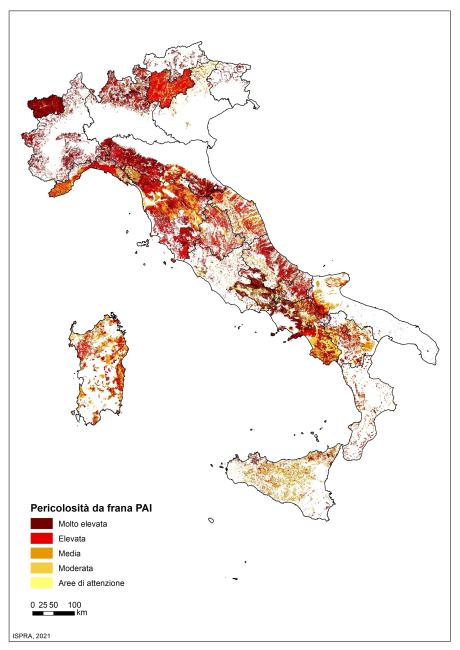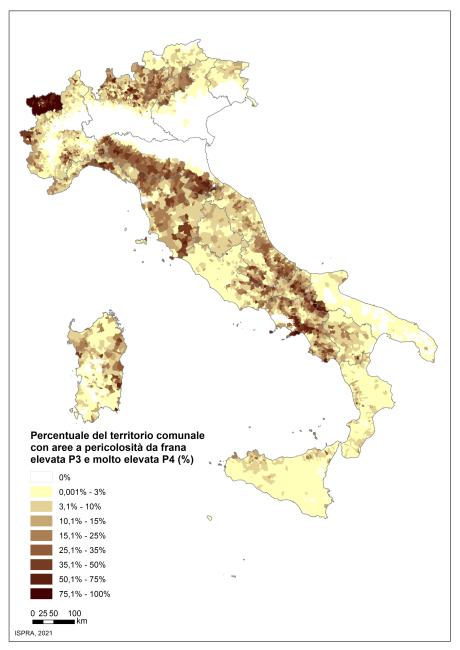Panel 1
Carla Iadanza, Alessandro Trigila
The indicator provides information on the landslide hazard zones of the River Basin Plans (PAI) at the national level. The total area in Italy affected by landslide hazard and attention zones in PAI is 60,481 km² (20% of the national territory), of which 26,385 km² (8.7%) subject to the most restrictive land use constraints, with high P3 and very high P4 hazard.
The indicator provides information on landslide hazard areas defined in the River Basin Plans (PAI), developed by the District Basin Authorities (former Basin Authorities) and by the Autonomous Provinces of Trento and Bolzano. Landslide hazard areas include, in addition to areas where landslides have already occurred, areas of possible evolution of existing landslides and areas potentially susceptible to new landslides.
ISPRA has developed the new national Mosaic (v. 4.0 - October 2021) of landslide hazard areas of the River Basin Plans (PAI), according to the harmonized legend in five classes for whole national territory: very high hazard P4, high hazard P3, medium hazard P2, moderate hazard P1, and attention zones AA. The legend was defined by ISPRA in 2015, in line with the Coordination and Guidance Act (DPCM September 29, 1998), and used for the previous versions of the Mosaic.
To provide an overview of landslide hazard areas in PAI at the national, regional, provincial, and municipal levels.
Collection, processing, archiving, and dissemination of data on soil protection and hydrogeological instability for the entire national territory (Article 55 of Legislative Decree 152/2006 “Environmental Regulations”; D.L. 180/98 “Sarno Decree” converted into Law 267/1998, DPCM of 29/09/98 - Guidance and Coordination Act, Law 365/00).
Panel 2
Trigila A., Iadanza C., Bussettini M., Lastoria B. (2018) Dissesto idrogeologico in Italia: pericolosità e indicatori di rischio. Edizione 2018. ISPRA, Rapporti 287/2018 (ISBN 978-88-448-0901-0)
-
-
Data quality assessment
Basin Authority
ISPRA (Superior Institute for Environmental Protection and Research)
Autonomous Provinces
National Mosaicing: https://idrogeo.isprambiente.it/
Cartography of Hydrogeological Structure Plans: sites of the District Basin Authorities and the Autonomous Provinces of Trento and Bolzano.
Nazionale, Regionale, Provinciale, Comunale
2020-2021
Indicator assessment
The national mosaic of landslide hazard zones was carried out through the analysis and harmonization, according to a legend in 5 classes for whole national territory (very high hazard P4, high hazard P3, medium hazard P2, moderate hazard P1, and attention zones AA), of the data provided by the District Basin Authorities and the Autonomous Provinces of Trento and Bolzano. The surface area of landslide hazard areas in PAI was then calculated on a regional, provincial, and municipal basis.
The total area in Italy of landslide hazard and attention areas according to the PAI is 60,481 km² (20% of the national territory), of which 26,385 km² (8.7%) subject to the most restrictive land use constraints, with high P3 and very high P4 hazard.
At present, the trend of the indicator cannot be defined due to the limited historical series available (2015, 2017, 2021).
Data
Tabella 1: Aree a pericolosità da frana PAI su base regionale – Mosaicatura 2021
ISPRA
* Limiti amministrativi ISTAT 2021.
** La Regione Autonoma Valle d'Aosta ha adottato, per le aree classificate a pericolosità elevata e media, vincoli assimilabili rispettivamente a P4 e P3; pertanto nella riclassificazione nazionale si è ritenuto di dare prevalenza alle misure di tutela del territorio piuttosto che alla nomenclatura adottata.
*** Relativamente al territorio della Calabria, il dato è stato calcolato sulla base del Piano di Assetto Idrogeologico – Rischio Frane - PAI 2001 dei territori dell’ex Autorità di Bacino Regionale Calabria (approvato dal Comitato Istituzionale con Delibera n. 13 del 29/10/2001, dal Consiglio Regionale con Delibera n. 115 del 28/12/2001; successive Delibere del Comitato Istituzionale dell’Autorità di Bacino Regionale della Calabria n. 26 del 02/08/2011 Procedure di aggiornamento PAI FR e FI e n. 27 del 02/08/2011 Testo aggiornato delle Norme di Attuazione e Misure di Salvaguardia - NdA). Nel precedente Rapporto ISPRA sul dissesto idrogeologico in Italia - Edizione 2018 il dato era stato invece calcolato sulla base del Progetto di Aggiornamento del Piano stralcio di bacino per l'Assetto Idrogeologico – PAI 2016 (Nota Segretario Generale Autorità di Bacino Regionale Calabria del 24/06/2016 Prot. n. 0203855), avviato con l’approvazione delle “Procedure per l’aggiornamento del Rischio Frane del PAI Calabria – Nuove Carte di Pericolosità e Rischio Frane” (Delibera del Comitato Istituzionale n. 3 del 11/04/2016), per il quale l’ex Autorità di Bacino Regionale Calabria aveva avviato la fase di concertazione con gli Enti territoriali. Tale Progetto di Piano non ha poi concluso l'iter di adozione. L’Autorità di Bacino Distrettuale dell'Appennino Meridionale ha attualmente in corso la revisione e aggiornamento di tutti i tematismi afferenti al sistema fisico, ai fenomeni franosi e alla pericolosità da frana.
I dati risentono delle disomogeneità di mappatura e classificazione, dovute principalmente alle differenti metodologie utilizzate dalle Autorità di Bacino Distrettuali e dalle Province Autonome per la valutazione della pericolosità da frana.
Tabella 2: Aree a pericolosità da frana PAI su base provinciale – Mosaicatura 2021
ISPRA
* Limiti amministrativi ISTAT 2021
I dati risentono delle disomogeneità di mappatura e classificazione, dovute principalmente alle differenti metodologie utilizzate dalle Autorità di Bacino Distrettuali e dalle Province Autonome per la valutazione della pericolosità da frana.




The total area in Italy of landslide hazard and attention areas according to the PAI is 60,481 km² (20% of the national territory) (Figure 1). The area of very high landslide hazard is 9,495 km² (3.1%), high hazard is 16,891 km² (5.6%), medium hazard is 14,551 km² (4.8%), moderate hazard is 12,556 km² (4.2%), and attention areas are 6,988 km² (2.3%). When considering the higher hazard classes (high P3 and very high P4), subject to the most restrictive land-use constraints, the total area amounts to 26,385 km², which is 8.7% of the national territory.
From the analysis of the landslide hazard mosaic along the national territory (Figure 1), local discrepancies in mapping and classification emerge.
Tuscany, Emilia-Romagna, Valle d'Aosta, Campania, Abruzzo, Sardinia, Piedmont, Lombardy, and the Autonomous Province of Trento have the largest areas (in km²) with high hazard P3 and very high hazard P4 (Table 1).
A comparison between the ISPRA national mosaic of 2021 and the one from 2017 shows an increase of 0.8% in the total classified area by the PAI (classes P4, P3, P2, P1, and AA), and a 3.8% increase in the higher hazard classes (high P3 and very high P4). Comparing the ISPRA national mosaics of 2017 and 2015, the increase was 2.9% in the total classified area by the PAI and 6.2% in the higher hazard classes. These variations are mainly related to the integration/revision of hazard maps by the District Basin Authorities and Autonomous Provinces, including more detailed studies, and to the mapping of new landslide phenomena. The most significant increases in high and very high hazard areas between the 2021 national mosaic and the 2017 mosaic occurred in the Autonomous Province of Bolzano, the territories of the Eastern Alps District Basin Authorities for the Veneto region, Po for the Piedmont region, Northern Apennines for the Arno basin and Tuscan basins, Southern Apennines for the Basilicata region, and in Sicily and Sardinia.
The national mosaic can be consulted on the national IdroGEO Platform (Figure 3).